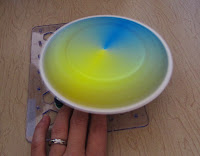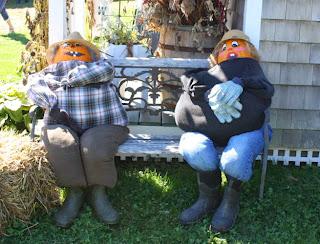by
RobinsFlight
Last week I did a series of science experiments with my son's kindergarten class. After all, I used to be a real scientist who did cancer research until I decided that raising my family was a more important job than even that. My son's teacher was more than happy to let me find some interesting things to do, based on that month's topic of discussion: colors.
In class they had already discussed how the primary colors of red, blue and yellow can be mixed to create orange, green and violet. They have some nifty experiments of their own. They had mixed colors of playdoh to create new ones. They split a stalk of celery into two at the base and put each side onto different colored water to see what happened as the colors rose up the stalk. And they mixed their own paints- the most fun being shaving cream paint.
I arrived hoping to expand their concepts a bit. And we did have fun. The experiments were did were spinning colored plates, playing with prisms to create rainbows, and marker chromatography.

The plate spinning was first. I use small paper plates, though you could use circles of cardstock of paper glued to cardboard. I colored half of each of 3 plates with the primary colors: red/blue, red/yellow and blue/yellow. I also made a colorwheel on a fourth plate, with sixth of each of the primary and secondary colors.

I borrowed my daughter's
snap circuits spinner for this one, though it could be done by threading string through two holes punched in the center of the plates and spinning that way also. I did try making a top out of the plates with either a toothpick or a pen, but it was hard to get them spinning fast enough to see the colors blend. I taped the propeller to the bottom of each plate, started the spinner, and we saw the primary colors blend to create their secondary color. Interestingly, the camera really didn't catch this nearly as seamlessly as our eyes did.

I also let the kids color their own plates with designs and colors they of their choosing. It was fun to see their designs turn to circles of color when the plates were spun.

With the colorwheel plate, the results are interesting. The colors blend to create a brownish shade, as you would expect if you were mixing paints. Yet if you looked at the edges where the plate was curving away from you, or if you slowed the motion somewhat, the colors paled, approximating white! The lesson? Combining all the colors makes white!

This led to our second experiment: playing with prisms. Most people have seen or even toyed around with a standard triangular prism. If not, imagine the iconic Pink Floyd symbol of the white light breaking into the rainbow as it shines through the prism. But more fun was trying out the multi-faceted prisms my husband happens to have. Rainbows galore! So we talked about how a rainbow in the sky is created by the sun shining through the rain, which breaks the white light into its colors.

Along with same line, do you know why the sky looks blue? If we look at the prism, we see that the blue and violet wavelengths (which are shorter) are bent more than the red and orange wavelengths (which are longer). The molecules of our atmosphere, the nitrogen and oxygen, scatter the light in the same way but to a much greater degree. Therefore, the blue parts of the sunlight are scattered significantly more- think of them bouncing around more and in many directions- than the red parts, which are virtually unchanged in terms of the direction they travel. So as we look at the sky, we see the blue light that has been scattered in every direction by the molecules in the atmosphere. As we look towards the horizon, the blue color gets paler because more of the blue light has been scattered elsewhere and we see more of just the complete white light. The violet wavelengths are also scattered. However, not only is there less violet in the light we see, since

much of it is absorbed by the upper atmosphere (as are some of the ultraviolet rays that cause sunburn), but our eyes also don't detect the violet as well, and we interpret the combination of blue/violet and the complete white light as the light blue of the sky. At sunset, the light looks more yellow to red because you are seeing more of the unscattered light as it flows through the edge of the atmosphere. Clear air tends to have a yellow shade at sunset, while more particulates in the air cause a more reddish hue.
 |
| Markers, clockwise from top: green, pink, black, brown, orange |
In the class, once we talked about rainbows, we transitioned to pigments- the colors that make up paint and, for our experiment, the ink in markers: marker chromatography. While it sounds impressive, it's basically separating pigments in the marker using water on filter paper- in this case, coffee filters. FYI, this experiment seems to work best with inexpensive markers. We flattened coffee filters on paper plates, and drew lines of different colors on the filters. Then with eye droppers, we put a drop or two of water near the lines and watched as the colors spread and separated as the water bled through the filters. Not only is it interesting to see what colors separate out of different markers, but this makes for a fun art project also! It does work best using only thin lines, not blocks of color, and only a few drops of water, as too much water just makes the marker bleed out of the filter and onto the plate below.

Did the kids learn a lot about colors? I don't know. Sometimes they absorb more than you think they do. But they definitely had fun playing with colors. And the teacher wants me to come back again when they move to a different topic: sound!
 |
| One child's marker filter before water |
 |
| Marker filter after water separation of marker pigments |

















































